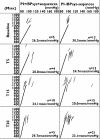Short-term effects of inhaled salbutamol on autonomic cardiovascular control in healthy subjects: a placebo-controlled study
- PMID: 19371312
- PMCID: PMC2679102
- DOI: 10.1111/j.1365-2125.2009.03377.x
Short-term effects of inhaled salbutamol on autonomic cardiovascular control in healthy subjects: a placebo-controlled study
Abstract
Aims: To investigate short-term effects of inhaled salbutamol on haemodynamic changes and cardiovascular autonomic control.
Methods: A randomized, single-blinded, placebo-controlled study of 0.2 mg of inhaled salbutamol was conducted on 12 healthy nonsmoking volunteers with a mean age of 24 +/- 2 years at two different testing sessions. Non-invasively obtained continuous haemodynamic measurements of cardiac output, beat-to-beat arterial blood pressure, and total peripheral resistance were recorded prior to and for a total of 120 min after inhalation of the respective study drug. Continuous cardiovascular autonomic tone was recorded using power spectral analysis of heart rate and blood pressure variability. Spontaneous baroreceptor activity was assessed by the sequence method.
Results: There were no significant changes in any of the baseline parameters between the different testing sessions. Inhalation of salbutamol caused a significant increase in cardiac output from 6.7 +/- 1.3 to 7.7 +/- 1.4 l min(-1) (P < 0.05), and a decrease in total peripheral resistance from 1076 +/- 192 to 905 +/- 172 dyne s(-1) cm(-5) (P < 0.05) within 15 min after inhalation. Moreover, salbutamol significantly increased sympathetically mediated low-frequency heart rate variability (P < 0.01), whereas parasympathetically mediated high-frequency heart rate variability decreased (P < 0.01). All changes persisted for approximately 30 min and were fully reversible at 120 min. There were no significant changes in systolic blood pressure variability or spontaneous baroreceptor activity.
Conclusions: Inhalation of therapeutic doses of salbutamol in healthy subjects resulted in significant haemodynamic changes and a shift of sympathovagal balance towards increased sympathetic tone in the absence of baroreceptor activation.
Figures




Similar articles
-
Altered cardiovascular autonomic regulation after 2-week inhaled salbutamol treatment in asthmatic children.Eur J Pediatr. 1997 Nov;156(11):883-8. doi: 10.1007/s004310050736. Eur J Pediatr. 1997. PMID: 9392406 Clinical Trial.
-
The acute effects of inhaled salbutamol on the beat-to-beat variability of heart rate and blood pressure assessed by spectral analysis.Br J Clin Pharmacol. 1997 Apr;43(4):421-8. doi: 10.1046/j.1365-2125.1997.00565.x. Br J Clin Pharmacol. 1997. PMID: 9146855 Free PMC article. Clinical Trial.
-
Effects of inhaled albuterol and ipratropium bromide on autonomic control of the cardiovascular system.Chest. 1997 Jun;111(6):1514-8. doi: 10.1378/chest.111.6.1514. Chest. 1997. PMID: 9187166 Clinical Trial.
-
Effects of an inhaled β2-agonist on cardiovascular function and sympathetic activity in healthy subjects.Pharmacotherapy. 2011 Aug;31(8):748-56. doi: 10.1592/phco.31.8.748. Pharmacotherapy. 2011. PMID: 21923601 Clinical Trial.
-
Non-invasive measurement of the haemodynamic effects of inhaled salbutamol, intravenous L-arginine and sublingual nitroglycerin.Br J Clin Pharmacol. 2009 Jul;68(1):23-33. doi: 10.1111/j.1365-2125.2009.03434.x. Br J Clin Pharmacol. 2009. PMID: 19660000 Free PMC article.
Cited by
-
Management of Chronic Obstructive Pulmonary Disease in Patients with Cardiovascular Diseases.Drugs. 2017 May;77(7):721-732. doi: 10.1007/s40265-017-0731-3. Drugs. 2017. PMID: 28349353 Review.
-
Autonomic dysfunction in patients with chronic obstructive pulmonary disease (COPD).J Thorac Dis. 2010 Dec;2(4):215-22. doi: 10.3978/j.issn.2072-1439.2010.02.04.5. J Thorac Dis. 2010. PMID: 22263050 Free PMC article.
-
Safety outcomes of salbutamol: A systematic review and meta-analysis.Clin Respir J. 2023 Dec;17(12):1254-1264. doi: 10.1111/crj.13711. Epub 2023 Oct 16. Clin Respir J. 2023. PMID: 37844914 Free PMC article.
-
Anesthetic considerations for patients with acute cervical spinal cord injury.Neural Regen Res. 2017 Mar;12(3):499-504. doi: 10.4103/1673-5374.202916. Neural Regen Res. 2017. PMID: 28469668 Free PMC article. Review.
-
Cardiac autonomic modulation induced by doxorubicin in a rodent model of colorectal cancer and the influence of fullerenol pretreatment.PLoS One. 2017 Jul 20;12(7):e0181632. doi: 10.1371/journal.pone.0181632. eCollection 2017. PLoS One. 2017. PMID: 28727839 Free PMC article.
References
-
- Crane J, Pearce N, Flatt A, Burgess C, Jackson R, Kwong T, Ball M, Beasley R. Prescribed fenoterol and death from asthma in New Zealand, 1981–83: case–control study. Lancet. 1989;I:917–22. - PubMed
-
- Sears MR, Taylor DR, Print CG, Lake DC, Li Q, Flannery EM, Yates DM, Lucas MK, Herbison GB. Regular inhaled beta-agonist treatment in bronchial asthma. Lancet. 1990;336:1391–6. - PubMed
-
- Sears MR. Short-acting beta-agonist research: a perspective 1997. Can Respir J. 2001;8:349–55. - PubMed
-
- Spitzer WO, Suissa S, Ernst P. The use of beta-agonists and the risk of death and near death from asthma. N Engl J Med. 1992;326:501–6. - PubMed
Publication types
MeSH terms
Substances
LinkOut - more resources
Full Text Sources
Miscellaneous

